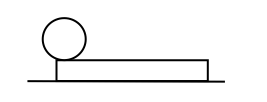B M Sharma Solutions for Chapter: Rigid Body Dynamics II, Exercise 3: DPP 3.3
B M Sharma Physics Solutions for Exercise - B M Sharma Solutions for Chapter: Rigid Body Dynamics II, Exercise 3: DPP 3.3
Attempt the free practice questions on Chapter 3: Rigid Body Dynamics II, Exercise 3: DPP 3.3 with hints and solutions to strengthen your understanding. Chapterwise/Topicwise Daily Practice Problems (DPP) Mechanics - II JEE Main & Advanced solutions are prepared by Experienced Embibe Experts.
Questions from B M Sharma Solutions for Chapter: Rigid Body Dynamics II, Exercise 3: DPP 3.3 with Hints & Solutions
A disc of mass and radius is placed on a rough horizontal surface. A cue of mass hits the disc at a height from the axis passing through centre and parallel to the surface as shown. The cue stops and falls down after the impact. The disc starts its motion as:

A cylinder moves with linear velocity to the right and angular velocity ω in the anticlockwise direction. The cylinder was initially at rest. The cylinder does not perform pure rolling and stops after some time. What will be the radius of the cylinder?
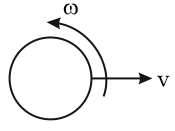
A solid sphere is set into rotation at an angular velocity and it is then, placed on a rough horizontal surface. The ratio of distances covered by rotational and translational motions up to the start of the pure rolling is (assume uniformly accelerated motion up to start of pure rolling):
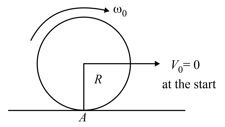
A sphere of mass is given some angular velocity about a horizontal axis through its center and gently placed on a plank of mass The coefficient of friction between the two is . The plank rests on a smooth horizontal surface. The initial acceleration of the center of sphere relative to the plank will be:
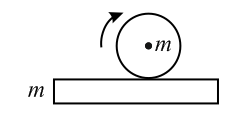
A cylinder rolls without slipping on a plank . The velocities of center of the cylinder and that of the plank are and respectively in the same direction with respect to the ground. The angular velocity of the cylinder, if its radius is is
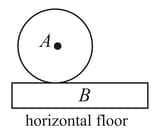
A rigid body undergoing uniform pure rolling encounters horizontal tracks and as shown is a smooth layer of ice and is a rough surface with Both and are rigid tracks. Which of the following statements are correct?

The body will slow down over .
The body will start slipping on .
The body remains in pure rolling over the whole stretch .
The angular velocity of the body remains constant over the whole stretch .
A spool is resting on a horizontal rough table. Forces and are applied separately as shown. all are applied tangentially to the inner circle. is horizontal, is vertical and is passing through the point of contact of spool and table. The correct statement is (assuming that there is no sliding)?
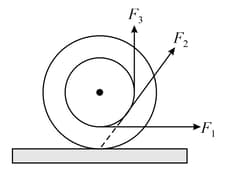
A cylinder of mass is placed on the edge of a plank of the same mass and length placed on the smooth horizontal surface, where is the coefficient of friction between cylinder and plank and is the time at which pure rolling starts. The cylinder is given an impulse at, which imparts it a velocity . The time in which pure rolling starts will be
